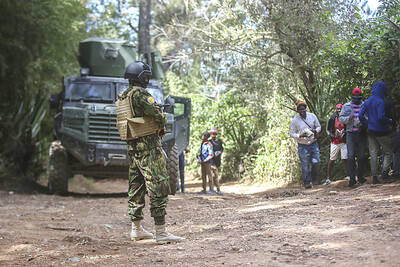A diplomatic storm is expected this week when Vietnam sends a boatload of tourists to its military outposts in the disputed Spratly archipelago in the South China Sea.
Despite warnings from Beijing, its powerful northern neighbor, about violating China's territorial sovereignty, Hanoi has vowed to press ahead with the inaugural trip which it has billed as a trial run.
Today, around 100 people carefully selected for their political credentials will leave the southern business capital of Ho Chi Minh City for the seven-day round trip.
Duong Xuan Hoi, deputy director of the Vietnam National Administration of Tourism, said the boat tour, which is being conducted under the auspices of the Ministry of Defence, had been in the pipeline since 1998.
But it was only officially announced last month, prompting an angry reaction from China and a cautious one from the Philippines.
Along with Taiwan, Malaysia and Brunei, they claim sovereignty over all or part of the Spratly Islands, which straddle vital shipping lanes and fishing grounds and are believed to contain vast oil and gas reserves.
Except for Brunei, all the claimants have military personnel scattered across the archipelago of more than 100 islets, reefs and atolls with a total land mass of less than 5km2.
Vietnam insisted on March 25 that it has "indisputable sovereignty" over the Spratlys, and that organizing such a tour within Vietnamese territory was "normal" behavior.
But China's foreign ministry called on Hanoi to respect a declaration signed in November 2002 by China and the 10 members of the Association of Southeast Asian Nations to avoid any actions which may heighten tensions.
The tension escalated a week later when Vietnam warned Taiwan that construction of a bird-watching shelter on a reef 6km from the largest Spratly island, Taiping, now controlled by Taiwan, could lead to reprisals.
Taipei shrugged off the threat and reasserted its territorial integrity over the entire flashpoint archipelago, which lies around two-thirds of the way from Vietnam's southeastern coast to the southern Philippines.
In the past, squabbling among the claimants to the Spratlys has erupted into violence. The most serious incident occurred in 1988 when Chinese and Vietnamese naval forces clashed at Johnson Reef, resulting in the deaths of 78 Vietnamese navy personnel.
The communist neighbors clashed again in the Spratlys in 1992, and since then there have been numerous other incidents between the six claimants.
Diplomats and analysts, however, say this week's boat trip is unlikely to trigger similar skirmishes but instead will most probably result in another round of verbal jousting.
"Vietnam has chosen a relatively non-provocative act that has no military dimensions," said Carl Thayer, an Asian affairs expert at the Australian Defence Force Academy in Canberra.
He believes that Hanoi is prepared to sacrifice diplomatic goodwill for the opportunity to showcase its claims to the Spratlys.
"Vietnam will proceed with the tourist trip to demonstrate its sovereignty over the features that it claims. This is part of a long-term strategy that both Vietnam and China engage in.

DITCH TACTICS: Kenyan officers were on their way to rescue Haitian police stuck in a ditch suspected to have been deliberately dug by Haitian gang members A Kenyan policeman deployed in Haiti has gone missing after violent gangs attacked a group of officers on a rescue mission, a UN-backed multinational security mission said in a statement yesterday. The Kenyan officers on Tuesday were on their way to rescue Haitian police stuck in a ditch “suspected to have been deliberately dug by gangs,” the statement said, adding that “specialized teams have been deployed” to search for the missing officer. Local media outlets in Haiti reported that the officer had been killed and videos of a lifeless man clothed in Kenyan uniform were shared on social media. Gang violence has left

US Vice President J.D. Vance on Friday accused Denmark of not having done enough to protect Greenland, when he visited the strategically placed and resource-rich Danish territory coveted by US President Donald Trump. Vance made his comment during a trip to the Pituffik Space Base in northwestern Greenland, a visit viewed by Copenhagen and Nuuk as a provocation. “Our message to Denmark is very simple: You have not done a good job by the people of Greenland,” Vance told a news conference. “You have under-invested in the people of Greenland, and you have under-invested in the security architecture of this

Japan unveiled a plan on Thursday to evacuate around 120,000 residents and tourists from its southern islets near Taiwan within six days in the event of an “emergency”. The plan was put together as “the security situation surrounding our nation grows severe” and with an “emergency” in mind, the government’s crisis management office said. Exactly what that emergency might be was left unspecified in the plan but it envisages the evacuation of around 120,000 people in five Japanese islets close to Taiwan. China claims Taiwan as part of its territory and has stepped up military pressure in recent years, including

UNREST: The authorities in Turkey arrested 13 Turkish journalists in five days, deported a BBC correspondent and on Thursday arrested a reporter from Sweden Waving flags and chanting slogans, many hundreds of thousands of anti-government demonstrators on Saturday rallied in Istanbul, Turkey, in defence of democracy after the arrest of Istanbul Mayor Ekrem Imamoglu which sparked Turkey’s worst street unrest in more than a decade. Under a cloudless blue sky, vast crowds gathered in Maltepe on the Asian side of Turkey’s biggest city on the eve of the Eid al-Fitr celebration which started yesterday, marking the end of Ramadan. Ozgur Ozel, chairman of the main opposition Republican People’s Party (CHP), which organized the rally, said there were 2.2 million people in the crowd, but